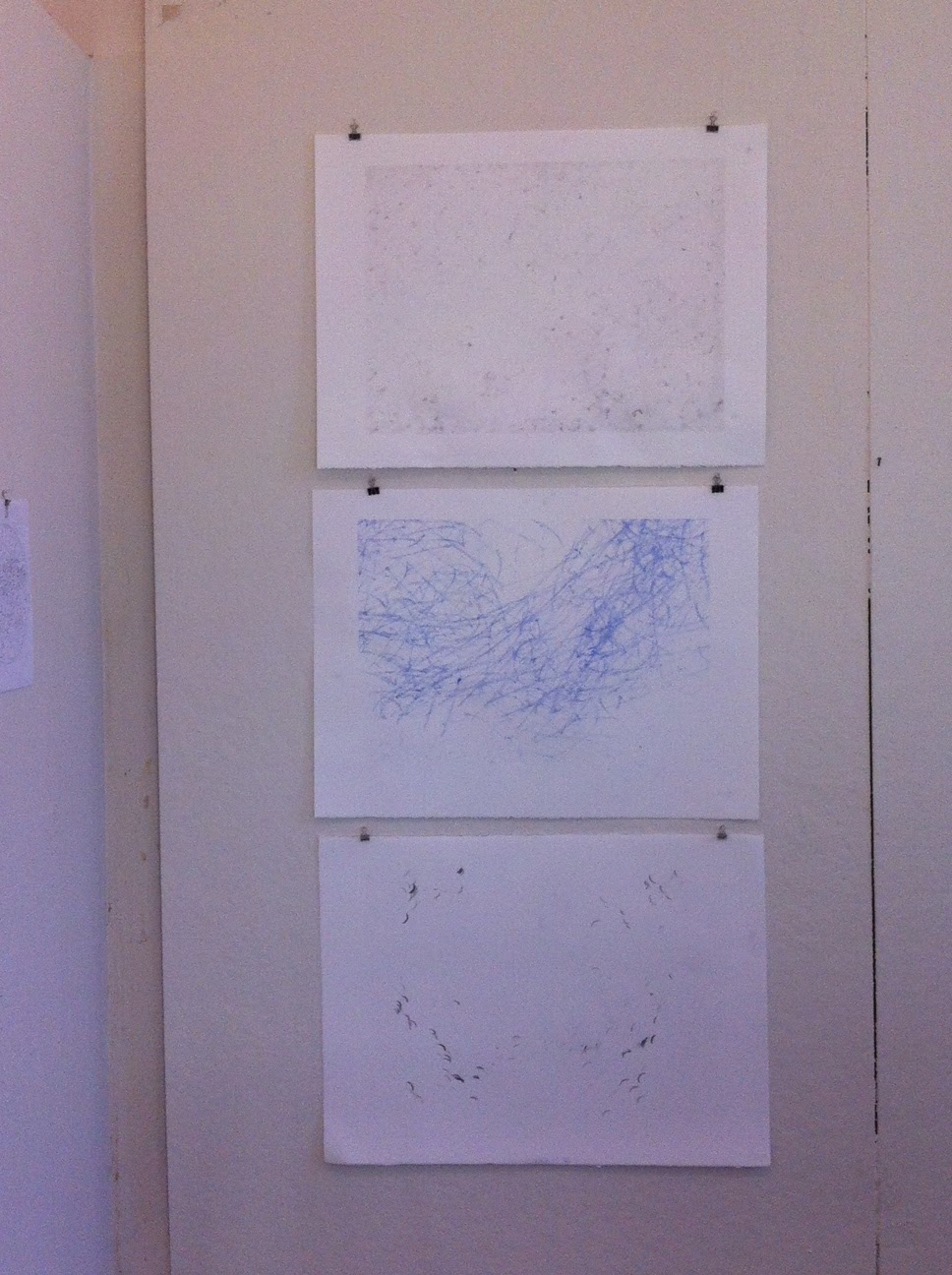Georgia’s Writ Crit
By Charlotte
The
first piece consists of a series of black and white etchings and graphite
drawings on paper laid out sequentially.
All the etchings are monotone aquatints depicting text, figures, and
sparse scenery. There is a wide range of
tones from pure white to pure black and they are all generally the same size,
except for one. The drawings are the
same ones we saw last semester, there are figures, text, and scenery with a
fair amount of rendering and realism.
All the images are displayed in a single line at eye level across the
wall. The content of the work suggest
that it should be read as a narrative from left to right. Some of the drawings from last semester have
been transformed into etchings, and some have been deleted all together.
The
second work is also laid out in two long horizontal lines composed of many
smaller images that are all printed in color on regular printer paper. The upper line of images is comprised of
photographs of the artist in various situations. The photos are sourced from the apple
photo-booth program, and are commonly referred to as selfies. The lower line of images shows screenshots of
word processor documents. Each one is
titled “Untitled 2” and contains blocks of text. The images are all rectangular shapes and
vary slightly in size.
Georgia’s
artist statement very effectively explains the concept of her work and the way
it means to address the plethora of issues mentioned and I actively searched
for these elements as I observed the work.
In the etchings the viewer really gets an idea of the realness of
oppression and the struggle to deny inheritance. The development of a symbol (Lilith’s
weapon/token bunch of reeds) is a huge step forward from the symbols we were
introduced to last semester. This work is
particularly strong in comparison to the other; it has a distinctive clarity of
idea and tone that the second piece lacks.
The second work represents a brave new direction for Georgia where she
has taken real ownership of her writing and has left behind the safety of her
classic drawing style. There are some
lines and narratives that can be followed through the diarist-type entries but it
is difficult to find a continuous thread.
For some of the images their accompanying text makes a lot of sense,
some of the others seem less purposeful.
There are so many issues that are mentioned in the text: queer, trans,
people of color, coming out, political deaths, autonomy, mental health,
gay/straight perception, agency, hetero-normalcy, etc. While the subjects make perfect sense with
Georgia’s statement, collectively they begin to feel like a political rant and
it is easy to lose the successful moments where she has shared something deeply
personal and relevant.
Historically
discussions of Georgia’s work have come to the difficult fact that the people
outside of your focus feel alienated by the work. There needs to be a dialogue that addresses
this feeling which may also have to do with a fear of critiquing something that
is not part of your own life. However,
the very specific and personal stories very effectively assuage these feelings. We really need to move beyond the
generalizations of movements and themes; they hide what we really want to know
about: you. Your experience makes us,
even forces us to understand.
Questions
1. In
the first work, it is significant that some of the images are etchings and some
of them are drawings,
·
Do the
drawings represent moments that require more sensitivity of mark?
·
Is this how
they will be displayed?
2. Text
has is suddenly playing a major role in both works, is the placement/word
choice working?
3. Do
the less serious selfies/confessions (friend tattoos and fuck the patriarchy)
work with the rest of the series?
·
Do the
selfies end up parodying themselves?
4. What
are you trying to say about these issues?
·
What’s YOUR
issue/who keeps YOU down? (ex. Adam keeps Lilith down, this is very clear, the
other work would benefit from the same clarity on your side of the equation)
Georgia’s Artist Statement:
My work is focused on the subjects
of lineage, trauma and mysticism with a queer and feminist lens. I take the
stories of dissenting and mythic women such as Lilith, Judith and St. Teresa,
and claim them into a contemporary archive through the literal re-drawing of
their mythologies into comics, zines and prints. My work makes use of instant
archives such as webcams, blogs and cell phone pictures alongside more
traditionally made prints and art historical images in order to insert these
mythologies into ordinary life.
The concept of “queering” something
in academic contexts means to come at something from the side, horizontally; to
attempt analysis without binaries and to tease out the layered complexities of
a subject that may sometimes contradicts itself. I am interested in queering
as
a methodology that is connected to and rooted in lived experiences of
structural oppression that force one to live in contradiction and survive
anyway. In the same vein, I am interested in the qualities of what I have termed
“the terrible inheritance” - a history that oppresses women and people of
color, requires patriarchal tools for their liberation and renders queerness
invisible. What are we to do with this
history? Short of renouncing what we cannot truly renounce, in what ways can we
use and claim these stories to build our own myths? My work attempts to locate
and document spaces of resistance and illuminate the complexities of my
contemporary identity: as a woman and a queer person, but also someone who
benefits from inherited power.
Artist Suggestions:
1. Francisco Goya
2.
3.
4.
Research/Reading Suggestions:
1.
2.
3.
4.





























